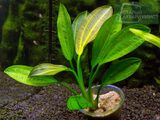Echinodorus scaber Rataj'

Origin / Breeder : Basionym von : Aquarius scaber (Rataj) Christenh. & Byng[1]
Synonym: Echinodorus macrophyllus subsp. scaber (Rataj) R.R.Haynes & Holm-Niels.
is widespread in Venezuela and Brazil. Echinodorus reaches a height of up to 30 cm, occupying an area of about the same diameter. It has a strong fibrous root system and white cord-like roots. Leaves of two types. The emergent leaves are dense, dark green, ovate, sometimes broad, heart-shaped, on long petioles, rough to the touch. The submerged leaves are large, light to dark green, oval or with a shallow heart-shaped incision, up to 15 cm long and up to 10 cm wide, with 5 veins clearly visible on the leaves, converging to an oval-pointed tip. For care you need soil, typical for all Echinodorus, neutral or slightly alkaline water with a temperature of 20 - 28 °C, medium to strong lighting. In an aquarium, the plant is planted in the middle ground. It reproduces mainly by seed. Reproduction by dormant buds on the rhizome is possible. Of the water plantains available to our aquarists, Echinodorus rough is the most interesting, although it is quite rare. This plant is characterized by being quite dense, tough and strong, which is not at all typical for aquatic plants. When you take it out of a well-lit aquarium, you are involuntarily surprised that it regularly keeps dense, rough leaves on short, dense leaf stalks both in the air and in the water. A young leaf of a plant often has large pigmented reddish-brown spots that quickly disappear from the front of the leaf plate as it grows and compresses. The general color of the plant is light green. The plant is compact, the leaf stalks are short and the large number of leaves form a magnificent rosette at the bottom, which is resistant to changes in the aquarium regime and does not change its shape. The rough Echinodorus bush can have a diameter of 30 - 35 cm, in which case neither other plants nor swimming fish can be seen behind it. The shape of the leaves varies greatly. Under favorable conditions in the aquarium, the plant retains all its leaves for a long time, and if they are not removed, they are pushed aside by the newly growing ones. In the end, a hemisphere of dense leaves forms on the bottom, often twisted at the edges and partially folded along the central vein of the leaves. It rarely reproduces under aquarium conditions. New plants appear on a fairly mature plant from the lateral axillary buds of the stem. There is no need to rush to separate the newly emerged plant. It should be allowed to grow its stem, roots and more leaves. This Echinodorus is unpretentious to aquarium conditions. It thrives both in old, silty aquarium soil and in relatively new, not too nutrient-rich soil. In the latter case, however, care must be taken to ensure that the total amount of light falling on the plant is not very high, otherwise the plant will lack mineral nutrition. The best daylight hours are 10 - 12 hours. The plant tolerates transplants well, but it is advisable to avoid them. Taking into account the possible growth up to 35 cm and a diameter of up to 30 cm, the right location for the plant must be chosen immediately.[2]
-
Echinodorus scaber Rataj[3]
-
Echinodorus scaber Rataj[3]
-
Echinodorus scaber Rataj[3]
-
Echinodorus scaber Rataj[3]
- ↑ POWO (2021). "Plants of the World Online. Facilitated by the Royal Botanic Gardens, Kew. Im Internet veröffentlicht; http://www.plantsoftheworldonline.org/ Abgerufen am 22. August 2021."
- ↑ Kostiantyn Loboda, Black Water http://echinodorus.com.ua/
- ↑ 3.0 3.1 3.2 3.3 Roman Trifonov, Moskau Aquarium Pflanzen http://www.staraqua.ru/




